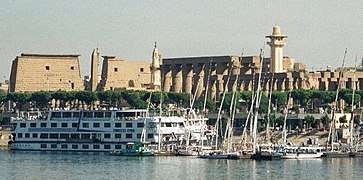Luxor Temple
Luxor Temple (Arabic: معبد الاقصر) is a large Ancient Egyptian temple complex located on the east bank of the Nile River in the city today known as Luxor (ancient Thebes) and was constructed approximately 1400 BCE. In the Egyptian language it is known as ipet resyt, "the southern sanctuary". In Luxor there are several great temples on the east and west banks. Four of the major mortuary temples visited by early travelers include the Temple of Seti I at Gurnah, the Temple of Hatshepsut at Deir el Bahri, the Temple of Ramesses II (a.k.a. Ramesseum), and the Temple of Ramesses III at Medinet Habu; the two primary cults' temples on the east bank are known as the Karnak and Luxor.[1] Unlike the other temples in Thebes, Luxor temple is not dedicated to a cult god or a deified version of the pharaoh in death. Instead, Luxor temple is dedicated to the rejuvenation of kingship; it may have been where many of the pharaohs of Egypt were crowned in reality or conceptually (as in the case of Alexander the Great, who claimed he was crowned at Luxor but may never have traveled south of Memphis, near modern Cairo).
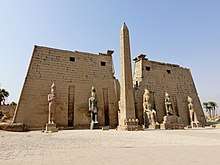 Entrance of the temple (first pylon) | |
 Shown within Egypt | |
| Location | Luxor, Luxor Governorate, Egypt |
|---|---|
| Region | Upper Egypt |
| Coordinates | 25°42′0″N 32°38′21″E |
| Type | Sanctuary |
| Part of | Thebes |
| History | |
| Founded | 1400 BCE |
| Site notes | |
| Official name | Temple of Luxor |
| Part of | Ancient Thebes with its Necropolis |
| Criteria | Cultural: (i), (iii), (vi) |
| Reference | 87-002 |
| Inscription | 1979 (3rd session) |
| Area | 7,390.16 ha (28.5336 sq mi) |
| Buffer zone | 443.55 ha (1.7126 sq mi) |
To the rear of the temple are chapels built by Amenhotep III of the 18th Dynasty, and Alexander. Other parts of the temple were built by Tutankhamun and Ramesses II. During the Roman era, the temple and its surroundings were a legionary fortress and the home of the Roman government in the area. During the Roman period a chapel inside the Luxor Temple originally dedicated to goddess Mut was transformed in to a Tetrarchy cult chapel and later into a church.[2]
Construction
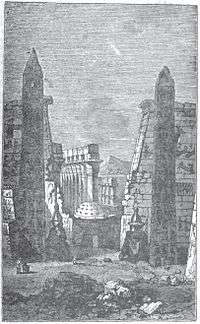
Luxor temple was built with sandstone from the Gebel el-Silsila area, which is located in South-Western Egypt.[3] This sandstone from the Gebel el-Silsila region is referred to as Nubian Sandstone.[3] This sandstone was used for the construction for monuments in Upper Egypt as well as in the course of past and current restoration works.[3]
Like other Egyptian structures a common technique used was symbolism, or illusionism.[4] For example, to the Egyptian, a sanctuary shaped like an Anubis Jackal was really Anubis.[4] At the Luxor temple, the two obelisks (the smaller one closer to the west is now at the Place de la Concorde in Paris) flanking the entrance were not the same height, but they created the illusion that they were.[4] With the layout of the temple they appear to be of equal height, but using illusionism, it enhances the relative distances hence making them look the same size to the wall behind it. Symbolically, it is a visual and spatial effect to emphasize the heights and distance from the wall, enhancing the already existing pathway.[4]
Excavation
From medieval times, the Muslim population of Luxor had settled in and around the temple, at the southward end of the mount.[1] Due to the Luxor's past city population building on top of and around the Luxor temple, centuries of rubble had accumulated, to the point where there was an artificial hill some 14.5 to 15 metres (48– 50 ft) in height.[1] The Luxor Temple had begun to be excavated by Professor Gaston Maspero after 1884 after he had been given the order to commence operations.[1] The excavations were carried out sporadically until 1960. Over time, accumulated rubbish of the ages had buried three quarters of the temple which contained the courts and colonnades which formed the nucleus of the Arab half of the modern village. Maspero had taken an interest earlier, and he had taken over the post of Mariette Pasha to complete the job in 1881. Not only was there rubbish, but there were also barracks, stores, houses, huts, pigeon towers, which needed to be removed in order to excavate the site. (There still exists a working mosque within the temple which was never removed.) Maspero received from the Egyptian minister of public works the authorization needed to obtain funds in order to negotiate compensation for the pieces of land covered by the houses and dependencies.
Festivals
The Luxor Temple was dedicated to the Theban Triad of the cult of the Royal Ka, Amun, Mut, and Khonsu and was built during the New Kingdom, the focus of the annual Opet Festival, in which a cult statue of Amun was paraded down the Nile from nearby Karnak Temple (ipet-sut) to stay there for a while, with his consort Mut, in a celebration of fertility – hence its name. However, other studies at the temple by the Epigraphic Survey team present a completely new interpretation of Luxor and its great annual festival (the Feast of Opet).[5] They have concluded that Luxor is the temple dedicated to the divine Egyptian ruler or, more precisely, to the cult of the Royal Ka.[5] Examples of the cult, of the Royal Ka can be seen with the colossal seated figures of the deified Ramesses II before the Pylon and at the entrance to the Colonnade are clearly Ka-statues, cult statues of the king as embodiment of the royal Ka.
Shrine stations
Six barque shrines, serving as way stations for the barques of the gods during festival processions, were set up on the avenue between the Karnak and Luxor Temple.[6] The avenue which went in a straight line between the Luxor Temple and the Karnak area was recently lined with human-headed sphinxes of Nekhtanebo I,21, in ancient times it is probable that these replaced earlier sphinxes which may have had different heads.[6] Along the avenue the stations were set up for ceremonies such as the Feast of Opet which held significance to temple.[6] Each station had a purpose, for example the fourth station was the station of Kamare, which cooled the oar of Amun.[6] The Fifth station of Kamare was the station which received the beauty of Amun.[6] Lastly the Sixth Station of Kamare was a shrine for Amun, Holy of Steps.[6] A small mud-brick shrine was built, in the courtyard of Nectanebo I, in early second century (126 CE) and was dedicated to Serapis and Isis, it was presented to Roman Emperor Hadrian on his birthday.[7]
Abu Haggag Mosque
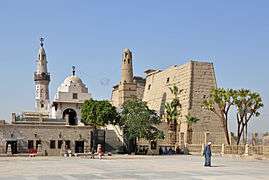
The active Abu Haggag Mosque (Arabic: مسجد أبو الحجاج بالأقصر) is located within the temple, standing on the ancient columns themselves. That part of the Luxor Temple was converted to a church by the Romans in 395 AD, and then to a mosque in 640, more than 3400 years of continuous religious worship [8]. Hence, the Luxor Temple is the oldest building in the world at least partially active for other than archeological or tourist purposes.
Defacement
In 2013, a Chinese student posted a picture of engraved graffiti that read "Ding Jinhao was here" (Chinese: 丁锦昊到此一游) in Chinese on a sculpture. This discovery spurred debate about increased tourism after the media confirmed a Chinese student caused this and other defacements. The engraving has since been partially cleared.[9]
Points of interest
- Sun court of Amenhotep III.
- The colossal statues of Ramese The great at the first pylon
 The Avenue of Sphinxes at night
The Avenue of Sphinxes at night Standing statue of Rameses II, modern day
Standing statue of Rameses II, modern day Standing statue of Rameses II, before excavations
Standing statue of Rameses II, before excavations- Processional colonnade of Amenhotep III
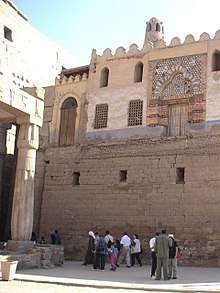 The Mosque abu al-Hallaj as seen from the court of Ramese II
The Mosque abu al-Hallaj as seen from the court of Ramese II
References
- Science, "Excavation of the Temple of Luxor," Science, 6, no. 6 (1885): 370.
- "Chapel of Imperial Cult". Madain Project. Retrieved 10 April 2019.
- Bernd Fitzner, Kurt Heinrichs, and Dennis La Bouchardiere, "Weathering damage on Pharaonic sandstone monuments in Luxor-Egypt," Building and Environment, 38 (2003): 1089.
- Alexander Badawy, "Illusionism in Egyptian Architecture," Studies in the Ancient Oriental Civilization, 35 (1969): 23.
- Lanny Bell, "Luxor Temple and the Cult of the Royal Ka," Journal of Near Eastern Studies, 44, no. 4 (1985): 251.
- Charles Nims, "Places about Thebes," Journal of Near Eastern Studies, 14, no. 2 (1955): 114.
- "Chapel of Serapis". Madain Project. Retrieved 26 May 2019.
- Fletcher, Joann (2013). The Search For Nefertiti. Hachette. p. 27. ISBN 9781444780543. Retrieved 21 August 2019.
- Hiufu Wong, CNN (27 May 2013). "Netizen outrage after Chinese tourist defaces Egyptian temple". CNN.
External links
| Wikimedia Commons has media related to Luxor Temple. |
